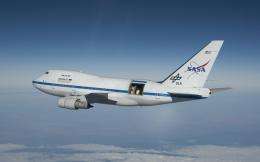Early results of the GREAT instrument onboard the SOFIA airborne observatory

Astronomy & Astrophysics is publishing a special feature devoted to the early results obtained during the first science flights of the airborne observatory SOFIA with the GREAT far-infrared instrument. We present 22 articles reporting on the technologies and the early astronomical results (including the first ever detection of new interstellar molecules).
Developed on the legacy of the Kuiper Airborne Observatory, which flew from 1974 to 1995, SOFIA performed its first science flight by the end of 2010, after a series of characterization flights. SOFIA flies at altitudes of up to 13700 meters, operating above 99.8% of the atmospheric water vapor. At these high altitudes, SOFIA allows access to wavelengths that would otherwise be blocked by absorption from the water vapor. During the Early Science phase, the GREAT far-infrared spectrometer was operated during a dozen science flights. It provides high-resolution observations at far-infrared wavelengths, between 60 and 240 μm, which cannot be accessed from the ground.
The high-resolving power of GREAT is designed for studying the interstellar gas and the stellar evolution, from a protostar's early phases to the evolved star's death. Many of the papers published in this special feature study the star formation process in its earliest phases, when the forming star is still strongly interacting with its parental molecular cloud. The high spectral resolution capabilities of GREAT allowed astronomers to study the physical conditions in the parent cloud in great detail and to probe the dynamics of the forming star. The scientists measured the velocity of the collapsing envelope in three protostars (Wyrowski et al.).
For the first time ever, two new interstellar molecular species were detected. Parise et al. discovered OD, an isotopic substitute for hydroxyl (OH), whose hydrogen atom is replaced by its heavier isotope, deuterium (see Fig. 3). It is an important marker in the formation of interstellar water and may serve as a chemical clock in the early star formation process. Neufeld et al. discovered interstellar sulfanyl (SH) while observing the source W49N.
Sahai et al. studied the remnant envelope of an evolved star ionized by its hot stellar core. Gusdorf et al. observed the violent shock interaction between a supernova remnant and its surrounding interstellar medium. Finally, galactic centers were also studied. For example, Requena-Torres et al. looked to the accretion disk that ultimately feeds the back hole in the center of the Milky Way, and Röllig et al. investigated the star formation in the nucleus of the nearby galaxy IC342. Pushing to technological frontiers, observations of the OH line at 120 μm explore new territories.
The handful of results of the GREAT first campaign reported in this A&A special feature only gives a first insight into the scientific potential of the SOFIA observatory. During routine operation, SOFIA is planned to fly about 120 flights per year with more than 960 hours of astronomical observations. The great advantage of airborne observatories is that they can take advantage of the rapid technological innovations, in particular at terahertz frequencies. In 2012 and 2013, the GREAT instrument will observe at wavelengths as short as 63 μm, and from 2014 on, the upGREAT array instrument will observe with 14 detectors simultaneously.
More information: A&A special feature: GREAT early science results Astronomy & Astrophysics, 2012, vol. 542, June 2012
Journal information: Astronomy & Astrophysics
Provided by Astronomy & Astrophysics




















